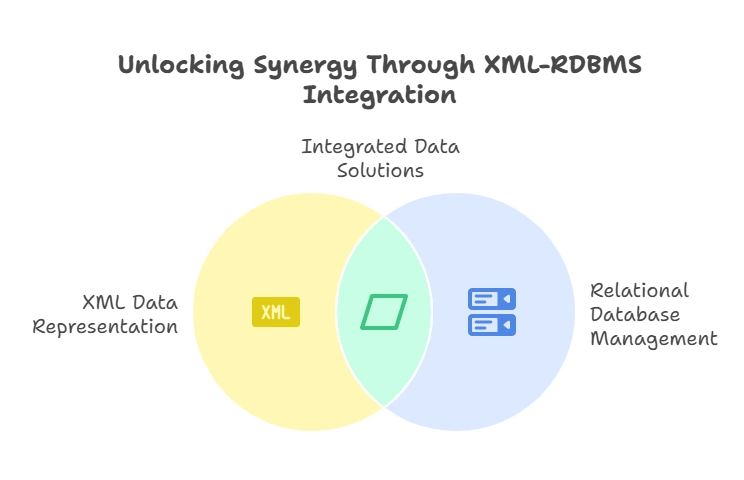Integrating XML with Relational Databases
Integrating XML with relational databases (RDBMS) is essential for leveraging structured relational data with the flexibility of XML. XML data is used in many applications for its portability and hierarchical structure, while relational databases are ideal for complex data relationships and query processing. This chapter will guide you through techniques for XML-RDBMS integration, including storage options, querying methods, and practical examples.
Introduction to XML and Relational Database Integration
XML and relational databases serve different purposes: XML represents hierarchical data, while RDBMS focuses on structured tabular data. Integration of XML with relational databases allows:
- Data Exchange: Seamless transfer between XML-based applications and relational data.
- Complex Data Handling: XML documents with nested structures can coexist with relational tables.
- Flexibility in Querying: Using SQL with XML support allows querying XML data directly within RDBMS.

Approaches to Storing XML in Relational Databases
There are three primary approaches to storing XML data in relational databases, each with its advantages and use cases.
Storing XML as Text or CLOB
XML data is stored as a large character object (CLOB) or text field, ideal for cases where the XML data doesn’t need to be queried frequently.
Example
CREATE TABLE Books (
id INT PRIMARY KEY,
title VARCHAR(100),
metadata XML
);
Here, metadata stores XML data as a CLOB. This approach keeps the original XML intact but limits querying flexibility.
Shredding XML into Relational Tables
Shredding is the process of decomposing XML into relational tables by mapping XML elements and attributes to columns and tables. This approach is useful when frequent querying or updating of XML content is needed.
Example: Shredding XML <Book><Title>XML Guide</Title><Author>Jane Doe</Author></Book> into relational tables.
CREATE TABLE Book (
id INT PRIMARY KEY,
Title VARCHAR(100),
Author VARCHAR(100)
);
INSERT INTO Book (id, Title, Author) VALUES (1, 'XML Guide', 'Jane Doe');
Storing XML as Native XML Data Type
Many databases, like SQL Server and Oracle, provide native XML data types, allowing direct storage of XML with specialized functions for querying.
Example in SQL Server:
CREATE TABLE Books (
id INT PRIMARY KEY,
title VARCHAR(100),
metadata XML
);
Querying XML Data in Relational Databases
Relational databases that support XML provide functions for querying XML data directly.
Using XPath Expressions
XPath allows navigation through XML data stored in relational databases.
Example: Fetch book titles from XML metadata.
SELECT metadata.value('(/Book/Title)[1]', 'VARCHAR(100)') AS Title
FROM Books;
This query uses XPath to retrieve the Title node within the metadata XML column.
XQuery for Advanced XML Queries
XQuery is another powerful language for querying XML data, especially useful for complex data retrieval.
Example:
SELECT metadata.query('/Book/Title') AS Title
FROM Books;
This query retrieves all titles as XML elements, allowing more flexible transformations.
XML Indexing for Faster Query Performance
Creating indexes on XML columns can speed up queries significantly.
Example
CREATE PRIMARY XML INDEX idx_metadata ON Books(metadata);
Transforming XML Data in Relational Databases
Transforming XML data allows converting it into various formats, which is useful when XML data needs to be displayed or exported.
Using FOR XML in SQL Server
FOR XML allows querying data and converting the output into XML format.
Example:
SELECT id, title
FROM Books
FOR XML AUTO;
This query outputs relational data as XML.
Converting XML to Relational Format
Using functions like OPENXML allows parsing XML and shredding it into relational rows.
Example:
DECLARE @xml XML = '<Books><Book><Title>XML Guide</Title></Book></Books>';
INSERT INTO Books (title)
SELECT T.Title.value('.', 'VARCHAR(100)')
FROM @xml.nodes('/Books/Book/Title') AS T(Title);
This example parses the XML document and inserts each title into the Books table.
Practical Scenarios of XML and Relational Database Integration
Data Interchange Between Systems
XML is often used for data interchange between different systems. By integrating XML with RDBMS, applications can easily export and import data in XML format, supporting interoperability.
Storing Configuration and Metadata
Many applications use XML for configuration. By storing XML configurations in databases, applications benefit from centralized management and querying capabilities.
Reporting and Document Generation
XML data stored in RDBMS can be used to generate reports or documents, combining the structured relational data with the hierarchical XML format.
sudo apt install gpg
Integrating XML with relational databases unlocks powerful capabilities for data management. Storing XML in RDBMS enables flexibility in data processing, supports complex queries, and allows structured and hierarchical data to coexist. Through techniques like shredding, native XML data types, and indexing, organizations can achieve high performance and flexibility in XML data handling.Happy coding !❤️
